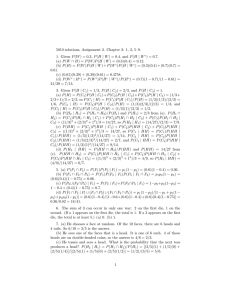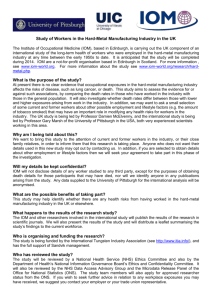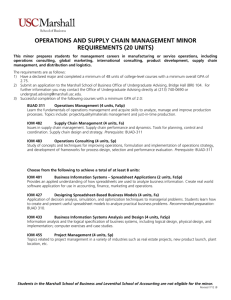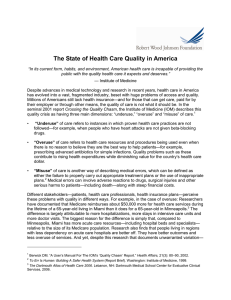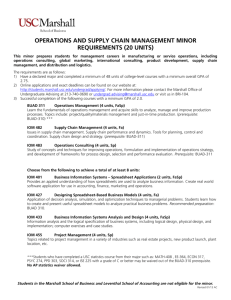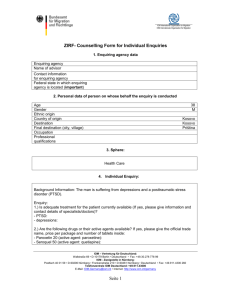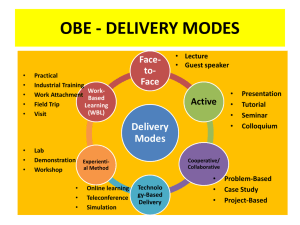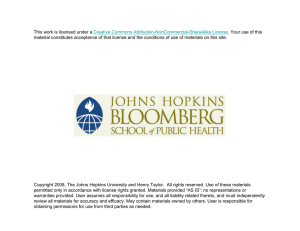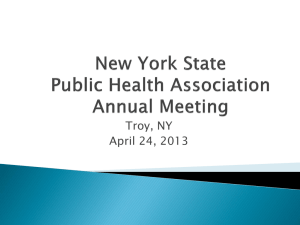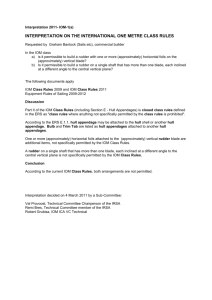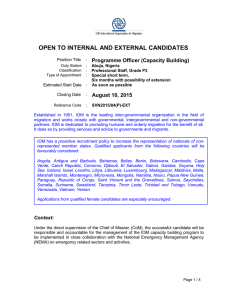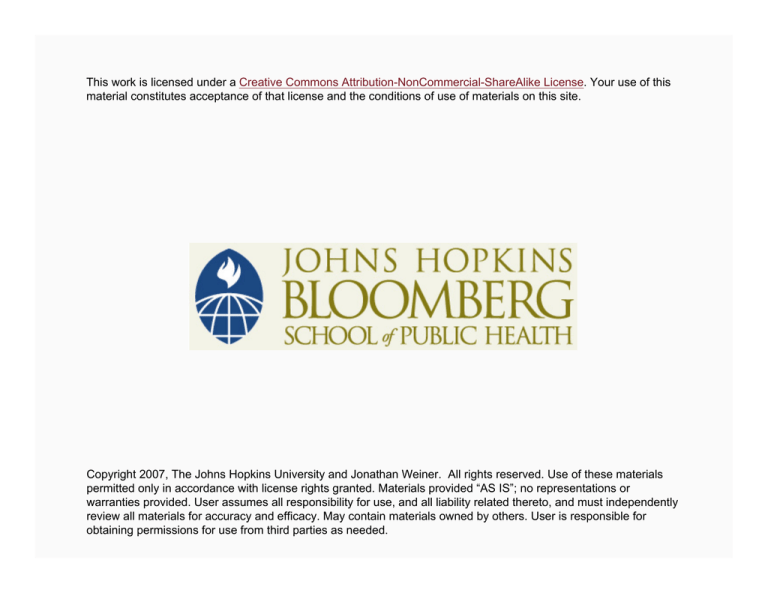
This work is licensed under a Creative Commons Attribution-NonCommercial-ShareAlike License. Your use of this
material constitutes acceptance of that license and the conditions of use of materials on this site.
Copyright 2007, The Johns Hopkins University and Jonathan Weiner. All rights reserved. Use of these materials
permitted only in accordance with license rights granted. Materials provided “AS IS”; no representations or
warranties provided. User assumes all responsibility for use, and all liability related thereto, and must independently
review all materials for accuracy and efficacy. May contain materials owned by others. User is responsible for
obtaining permissions for use from third parties as needed.
Quality of Care and Its Measurement in the HSRE
Context
Jonathan P. Weiner, DrPH
Johns Hopkins University
This Lecture Will Address the Following:
Definitions
Paradigms and frameworks
Policy context
Applications within HSR&E
Approaches to measurement
Sources of benchmarks
Data sources
Practical issues (related to “individual exercise” case study)
3
Section A
Definitions, Paradigms, and Frameworks
“Quality” Defined
The degree to which health services for individuals and
populations increase the likelihood of desired health
outcomes
And the degree to which health services are consistent with
current professional knowledge
Notes Available
5
“Quality” Defined
The quality “performance” of a provider or organization can
be assessed by measuring . . .
− Their patients’ outcomes (end-results), or;
− The degree to which they adhere to an accepted care
process
6
“Quality” Defined
Everything that’s not money
− Weiner, 1982
7
The “Value” Equation
Cost
Value
Quality
8
The Theoretical Cost/Quality “Plateau” Relationship
A
B
Quality
Cost
9
Two Recent Institute of Medicine Reports Have Been
Influential:
“To Err is Human”
“Crossing the Quality Chasm”
− Though as much political as scientific in nature, we can
learn much from these IOM reports
− See www.iom.edu
10
IOM’s Framework for Quality Improvement:
Quality problems may relate to the following:
− Underuse
− Overuse
− Misuse
The IOM effectively used the issue of “patient safety” to
capture the public’s attention and the media’s attention
11
IOM’s Suggestions for Future
It is not acceptable to have a wide “quality chasm” between
actual and best possible performance
Quality and safety must be designed into a system and must
not be the responsibility of just individual providers
12
Is It HSRE or Care Management?
Quality of care is central to several domains:
− Basic research and development
− Research to set policy agenda
− Program management/improvement
− Program impact evaluation
13
A Schema for Categorizing Health Services Research,
Evaluation, and Related Activities
Science
base
New Knowledge for Society
Research
Methods development
Outcomes/tech assessment
CQI
OR/efficiency
Disease/outcome
management
Program
management
Social policy research
Health system
improvement and
development
Performance monitoring
Program effectiveness
Program
Assessment /
Development
Non-policy
Policy
Policy research /
analysis
Provider/Program Focus
Evaluation
Policy Makers (public and private)
14
A Schema for Categorizing Health Services Research,
Evaluation, and Related Activities
Science
base
New Knowledge for Society
Research
Methods development
Outcomes/tech assessment
CQI
OR/efficiency
Disease/outcome
management
Program
management
Social policy research
Health system
improvement and
development
Performance monitoring
Program effectiveness
Program
Assessment /
Development
Non-policy
Policy
Policy research /
analysis
Provider/Program Focus
Evaluation
Policy Makers (public and private)
15
Some Specific QOC Applications Include . . .
Clinical quality improvement / TQM
Performance monitoring
Evidence-based outcomes research
Health system improvement
16
The “Continuous Quality Improvement” (CQI) Cycle
Problem Identification
and Prioritization
Implementation of System Change
Determination of Quality Criteria
Design of System Improvement
Measurement of Degree
to which Criteria is Attained
17
Section B
Measurement
Approaches to Measuring Quality
1. Structure of care
− Facilities
− Provider qualifications and credentialing
− Availability / resource adequacy
19
Approaches to Measuring Quality
2. Process of care
− Provider adherence to practice standards
− Appropriateness of care
20
Process Measures
Adequacy of patient/population utilization
Ease of access to care/case finding rates
21
Approaches to Measuring Quality
3. Outcomes of care
− Patient function/health status/quality of life
− Adverse/sentinel events
− Mortality/longevity
22
Outcome Measures
Prevention/avoiding disease/morbidity
Patient satisfaction/patient-centeredness
23
Data Sources for Quality
Type of Measure
Data Source
Structure
Site Visit
X
Administrative Files
X
Claims/Encounter
Process
Outcome
X
X
X
X
24
Data Sources for Quality
Type of Measure
Data Source
Structure
Site Visit
X
Administrative Files
X
Claims/Encounter
Process
Outcome
X
X
X
X
25
Data Sources for Quality
Type of Measure
Data Source
Structure
Medical Record (paper or
electronic)
X
Patient Interview
X
Population Survey
Process
Outcome
X
X
X
X
26
Remember Your “Denominators”:
Populations of Interest for QOC Research
Insured beneficiary/enrollee group
Persons living in a geographic area
A selected vulnerable population group
Provider organization/institution
An individual provider
27
Basis for QOC Standard/Reference
Process or structure of care:
Normative—based on peer judgment and literature
Empirical—based on observations of actual practices
See http://www.qualitymeasures.ahrq.gov/
(http://www.ahrq.gov/qual/)
28
Standard/Reference
Outcomes of care:
Accepted standards with face validity (e.g., infant mortality,
disability)
Constructed standards (e.g., functional health status,
satisfaction)
29
QOC Case Study (See Individual Exercise)
1. CABG in Western MD
2. Prenatal care “gray-area” women
− Meeting national standards of care
− Improved quality for target population
A. Intent and implications for design
B. Measures
C. Sources of data
30

